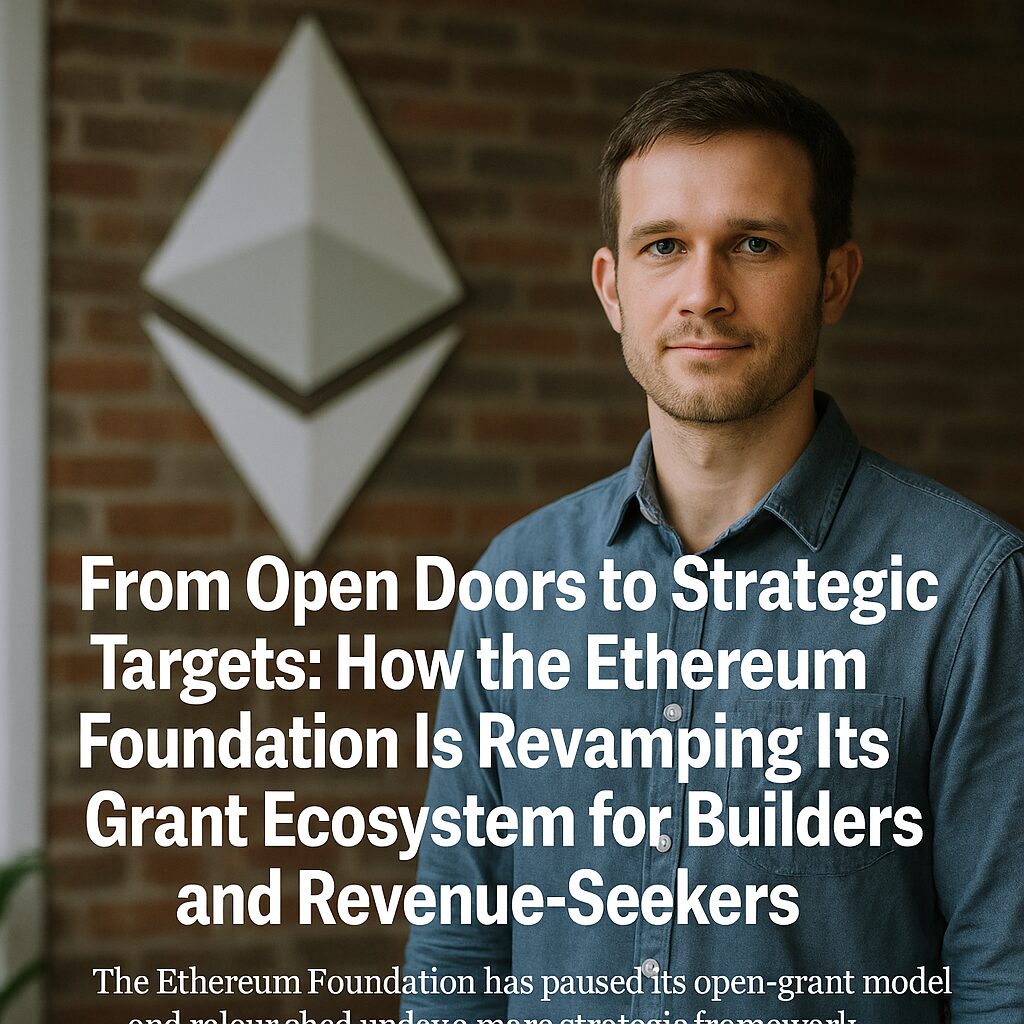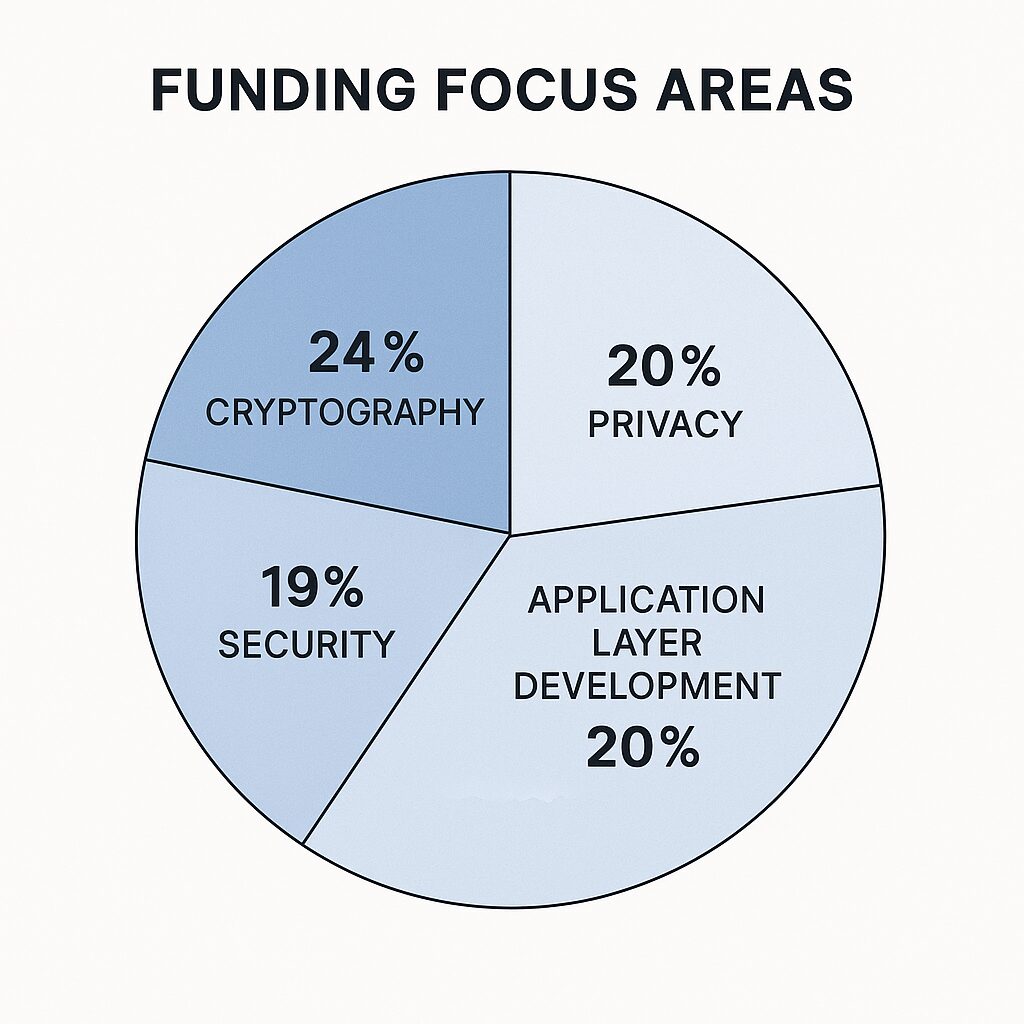
Main Points :
- The Ethereum Foundation has paused its open-grant model and relaunched under a more strategic framework.
- The new structure uses two funding channels: a “Wishlist” of priority areas and formal Requests for Proposals (RFPs).
- This shift is aligned with broader ecosystem events, including the upcoming Fusaka Upgrade and increased emphasis on cryptography, privacy, security, tools and community growth.
- For developers, entrepreneurs, and builders seeking new revenue and token opportunities, this means a clearer framework and possibly higher signal-to-noise in grant competition.
- From a practical blockchain-use standpoint, this shift indicates that ecosystem funding is moving from broad opportunistic grants toward more mission-oriented, targeted investments with measurable outcomes.
- The change may influence how new crypto assets, infrastructure tools, and application layers are funded and launched—for projects seeking next-gen opportunities, this is important context.
1. Background: A Successful but Strained Open Grants Model
Since 2018, the Ethereum Foundation’s grants programme has supported developers, researchers, and community builders working on infrastructure, tooling, education, open-standards and more. In 2024 alone, the Foundation distributed around USD 3 million to 105 projects under the open grants programme.
Yet by mid-2025, the volume of applications had grown so large that the Foundation flagged resource constraints: “the growing volume of applications stretched our resources, limiting our ability to pursue strategic opportunities.”
In response, the open application model was temporarily paused to allow a redesign of the funding approach.
For builders and new-asset seekers, this means that the “wild west” phase of open grants is ending—or at least evolving.
2. The New Grant Framework: Wishlist + RFP
Wishlist

Under the new structure, the Foundation publishes a Wishlist: a set of broad themes and priority areas where it believes significant opportunities or gaps exist. The Wishlist is less about predefined projects and more about signalling high-impact zones: cryptography, privacy, application layer development, security, community growth. Projects that align with these themes can propose innovative solutions.
Requests for Proposals (RFPs)
In parallel, the RFP channel invites proposals that address specific problems, deliverables, and target outcomes. Each RFP defines a scope, expected results, timeline and evaluation criteria.
This dual-path model aims to strike a balance: allow creativity (via Wishlist) while ensuring targeted funding for critical ecosystem needs (via RFP). Wizards of Web3 who are looking for next-generation assets, tools or platforms may find that responding to RFPs offers clearer route-to-funding than purely speculative grant hunting.
3. Strategic Alignment with Ethereum’s Technical Roadmap
The timing of this overhaul is notable. The Foundation’s announcement came as Pectra Upgrade (launched earlier) had improved staking operations and wallet UX, and the upcoming Fusaka upgrade (scheduled for December 3, 2025) is expected to introduce key EIPs supporting scalability, partial data retrieval (EIP-7594) and parallel execution (EIP-7825 / 7935).
By aligning funding with roadmap priorities, the Foundation signals that grants will increasingly support infrastructure, protocol evolution, and ecosystem foundational layers, rather than purely application-layer or speculative tokens. For those searching for next revenue streams, this suggests that tooling, infrastructure and protocol-adjacent projects may attract funding — and potentially value.
4. Implications for Builders, New Assets and Blockchain Applications
For Builders & Developers
- Projects seeking grants should orient to the specified channels (Wishlist / RFP) rather than expecting purely open door access.
- Proposals will likely need clearer deliverables, alignment with ecosystem priorities, and measurable outcomes (especially for RFPs).
- The shift may reduce “spray and pray” grant applications and favor fewer, higher-impact projects.
- Communities and infrastructure layers (privacy, security, dev tools) may be especially favoured now.
For New Crypto Assets / Tokens
- Projects issuing tokens may benefit if they align with infrastructure development or public good tooling rather than purely speculative features.
- The foundation’s roadmap alignment suggests that tokens or platforms supporting privacy, cryptography, data availability, L2 tooling or developer adoption may find fertile ground.
- Understanding where funding is flowing can hint at where value creation opportunities may arise.
For Practical Blockchain Use Cases
- Ecosystem tooling (developer SDKs, cross-protocol relayers, privacy frameworks) will likely receive more support; this is relevant for implementers building real-world systems.
- The model suggests increased ecosystem maturity: fewer random grants, more strategic funding aimed at long-term infrastructure. That benefits practitioners in that they may build on more robust, well-funded foundations.
- For non-custodial wallet builders (such as your own “dzilla Wallet”) or teams building swap/bridge functionality, the funding signals emphasise things like privacy, security, application layer support — valuable pointers for aligning product features.
5. Recent Trends & Context in Web3 Grants Landscape

Beyond the Ethereum Foundation’s announcement, we can observe broader market dynamics:
- Research on Web3 grant programmes suggests that maturity models are emerging: frameworks like the “Grant Maturity Framework” show that grant programmes are evolving from experimental to advanced operational maturity.
- The bigger trend is that ecosystems are becoming more strategic in funding: they want measurable outcomes, public-good infrastructure, developer adoption, community growth — not just token launches.
- In this context, the Ethereum Foundation’s shift is consistent with how mature systems allocate resources: more targeted, less open-ended, better aligned with roadmap and ecosystem value creation.
For you, as someone focused on developing non-custodial wallet infrastructure, token presales, and exploring new blockchain income opportunities, the economic and structural environment of grant funding matters: understanding how funding flows means you can align your initiatives (wallet features, token mechanics, community growth) to topics likely to be prioritised (privacy, security, tooling, adoption).
6. What to Watch & Actionable Steps
What to watch:
- Check the ESP website (the Foundation’s grant portal) for live Wishlist items and RFPs covering cryptography, privacy, security, application layer development.
- Monitor announcements related to the Fusaka upgrade and related EIPs: as the infrastructure evolves, new gaps and opportunities will open for tooling, developer adoption, audits, security.
- Observe how other ecosystems structure their grants programmes: for example, studies show that more mature programmes emphasise clear metrics, governance and measurable outcomes.
- For token or product strategy, consider building around the priority areas flagged in the Wishlist — align to privacy, cryptography, tooling, community growth.
Actionable Steps for you:
- If you’re working on your wallet (“dzilla Wallet”) design or token issuance platform: frame a proposal (or align product specs) around privacy-enhanced wallet features, developer toolkits, or integration with protocol upgrades — this may match Wishlist or RFP themes.
- Consider creating a minimum viable proposal in advance of RFP launches: identify a clear problem (e.g., developer onboarding friction in the wallet, privacy leakage, cross-protocol swaps), define deliverables, timeline, measurable outcomes — this aligns with RFP expectations.
- For token issuance/presale platforms: highlight how your product supports ecosystem growth (tooling, infrastructure, adoption) rather than purely speculative token mint. This may improve alignment with funding priorities and ecosystem legitimacy.
- Build community growth or developer adoption plans as part of the project: the Foundation has flagged community growth as a priority pillar.
- Keep an eye on budget sizes, grant cap expectations (previous grants were moderate; the new model may be selective). Develop budget and resource plan accordingly.
7. Conclusion
The Ethereum Foundation’s transformation of its grant programme marks a significant inflection point for the Ethereum ecosystem. For years, the open-grant model facilitated broad experimentation and builder support; now, the shift toward a Wishlist + RFP model signals a maturation of ecosystem funding — more strategic, more aligned, more outcome-driven.
For builders, developers, and teams seeking new blockchain opportunities, this change offers both challenge and clarity: less randomness in grant access, but more alignment possibility if you match the ecosystem’s priorities. For token creators and platform builders, the signal is clear: infrastructure, tooling, privacy, security, community adoption are where funding and value may concentrate.
Given your interests in non-custodial wallet design, token presales and blockchain application use-cases, this is a timely moment to align your project roadmap with the strategic vectors signalled by the Ethereum Foundation. By doing so, you increase your chances of accessing ecosystem grants, forming partnerships, and positioning your initiative within the next wave of meaningful Web3 innovation.

